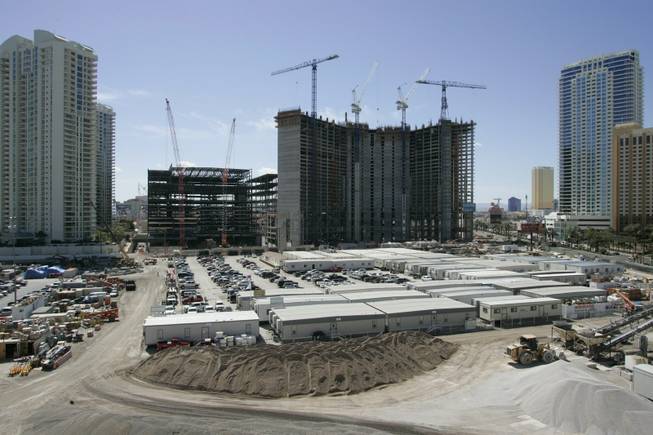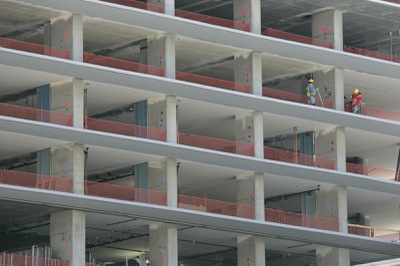
Ironworkers at the Fontainebleau Las Vegas staged a rare work stoppage in July in an attempt to improve safety at the site. Three days after work resumed, a worker died.
Sunday, April 13, 2008 | 2 a.m.
Sun Topics
The 70-odd ironworkers working at the Fontainebleau construction site were fed up with dangerous conditions.
In July, they stopped working in the unsafe areas and persuaded their union, Irownworkers Local 433, to negotiate with the contractor to correct several specific safety problems: They wanted a caged elevator, not an open lift, to ride to higher floors. They demanded installation of a promised cable so they could attach their safety harnesses. They wanted the safety net, then balled up somewhere on the site, stretched beneath workers, where it belonged.
Work resumed after three days, but dangerous practices continued. Three days later, the contractor relied on a makeshift hook that state investigators later said should never have been used.
The hook broke. Apprentice Norvin Tsosie fell to his death, becoming one of nine workers who, the Las Vegas Sun has reported, died in construction accidents on the Strip in the past 16 months.
Workers had failed to force a subcontractor, Nevada Prefab Engineers, to make the site safe. But they tried — and persuaded their union to back them up. By most accounts, that hasn’t happened often on the $32 billion in projects under way on the Strip.
In a town where powerful service unions, including the Culinary Union and the Service Employees International Union, pride themselves as being wary adversaries of management, construction trade unions have shown reluctance to confront contractors over safety. That often leaves workers themselves as the last resort.
The Sun reported two weeks ago that safety has been overlooked in the rush to build on the Strip. (The owner and contractors involved at the Fontainebleau did not respond to calls for comment.)
Investigators for Nevada’s Occupational Safety and Health Administration have found a troubling pattern of contractor safety violations on the massive, complicated and fast-paced projects, including failure to ensure that workers are properly trained, allowing workers to use faulty equipment and leaving workers exposed to falls by not covering or guarding gaping holes or not placing temporary planks or netting below.
Despite that, the state agency has exercised lax oversight, often withdrawing citations during informal meetings with contractors.
Some workers believe their unions could be more aggressive with management, especially at a time when union locals say they are growing rapidly.
“Here in Las Vegas, as far as the need for union workers goes, we have leverage like you can only dream of,” said a union steward who spoke to the Sun on the condition that he would not be identified. “If we stand up over safety, imagine how much attention we would get and how much work would not be happening.
“The next project is always bigger than the last, but (the contractors) have to listen to us if we do it right.”
But unions say they are already diligent about safety. “If we really thought these sites were off the beaten track we’d pull our guys,” said Marc Furman, president of the Southwest Regional Council of Carpenters. Furman said accidents are inevitable in a high-risk environment. “There are all these safety meetings, and (the contractors) are really doing the best they can.”
The carpenters union lost two members in an accident at CityCenter last year.
Laborers International Union Local 872 also lost two workers. Union official Joe Taylor, who is executive director of the Laborers-Employers Cooperation and Education Trust, a training center, said that if laborers exercise their rights to stop working in an unsafe environment and take their concerns to their union, it puts the responsibility on the company.
But neither Taylor nor an organizer for the union who spoke to the Sun could recall any time that workers joined together to stop working in unsafe areas.
David Montgomery, professor emeritus of history at Yale University, said the go-easy approach by union locals follows a decadelong trend of accommodation among the country’s building trades.
As national construction firms have squeezed many local contractors out of work, union locals have lost much of their leverage, Montgomery said. Their biggest fear is that the giant national contractors will build with nonunion workers, so the unions try to maintain tight relations with those contractors.
The workers share that concern. “You don’t have to be fired. You just have to not be hired tomorrow,” said Jim Platner, an associate director of the Center for Construction Research and Training, the research arm of the AFL-CIO’s Building and Construction Trades Department. “Workers are unlikely to support an action that will make them lose a mortgage payment.”
Worker militancy is commensurate with the amount of work in a given market, Platner said.
“If this is the only show in town — and you’ll have to travel or be on the call list for the next month — people hesitate to be very militant,” Platner said. “It’s more economics than politics.”
Platner said the construction industry also has less labor-management tension because many union members have also been contractors. “There is a fair number who go back and forth,” he said. “That changes people’s perspectives a little bit.”
When problems do arise, the union’s avenues for action are limited by contracts that include no-strike clauses and federal labor law prohibiting so-called “secondary boycotts,” or the picketing of a job site by a particular craft.
Individual workers can by law refuse to work in unsafe conditions — but those who do often find themselves fired for other reasons, members and labor leaders say.
“You got to remember there’s a fantasy world and a real-life world,” said Frank Migliaccio, director of safety and health for the Ironworkers International Union. “The real-life world is, I didn’t fire you because you refused to work, I fired you because you came back to work three minutes late from lunch. And what recourse would you have?”
Despite that, labor experts say unions in Las Vegas should be proactive. They could increase training at joint labor-management trusts, lobby owners to demand safety-conscious designs, and work with contractors to improve training for foremen and supervisors.
“I think the unions have a lot of work to do to get their own members — foremen, journeymen and apprentices — moving in the same direction,” Platner said.
So far, much of the union response to accidents on the Strip has centered on safety training.
After laborer foreman Willie Pelayo backed a malfunctioning buggy into an elevator shaft in December 2006, for example, the laborers union bought a buggy and began training workers on its use, Taylor said.
But some within the labor movement want more fundamental changes. They are trying to change the safety culture.
The ironworkers union, for example, has begun meeting monthly with construction company safety engineers and OSHA representatives to air safety concerns.
And this month the AFL-CIO’s research arm, the Center for Construction Research and Training, will meet with Steve Ross, head of the Southern Nevada Building and Construction Trades Council, and representatives of Perini Building Company, the largest general contractor on the Strip, to talk about root causes of safety violations at CityCenter.
That approach was prompted by Mark Ayers, president of the building trades arm of the AFL-CIO, who became concerned about the number of construction deaths in Las Vegas. Ross did not return calls from the Sun seeking comment.
Unions are also starting to consider becoming more heavily involved in OSHA investigations, a process they had, until recently, mostly chosen to sit out.
In February 2007, then-Nevada OSHA inspector Randy Schlecht arrived at CityCenter after two carpenters died when crushed by two heavy pieces of aluminum. It seemed clear that speed, miscommunication among supervisors, and a lack of training had led to the tragedy.
But Schlecht had a tough task ahead. He was up against construction giant Perini, and he knew his agency tended to tread lightly when going up against Strip contractors. He thought the carpenters union could help provide some balance.
Schlecht said that on that first day, he met with several representatives of the carpenters union.
“We’re talking about two people dead,” he said. “With their help, not only do I have the regulations and the code in my favor. If I get the union behind me, too ... now we have strength.”
But Schlecht said the carpenters union declined to become involved.
Furman, of the carpenters union, said he does not recall speaking with Schlecht.
As with every other union that represents a worker who died on the Strip recently, the carpenters did not attend the informal conference during which OSHA whittles away citations. Union heads say they did not know they could attend the conferences until the Sun began reporting on the process.
But they also said they have little faith in the agency and see institutional reform at OSHA as more important than individual negotiations.
“There should be fair representation of your members,” Platner said. “You ought to be out there swinging the bat. But I can understand why they’d be frustrated with the system. They’re thinking, ‘Why play the game if it’s fixed?’ ”


Join the Discussion:
Check this out for a full explanation of our conversion to the LiveFyre commenting system and instructions on how to sign up for an account.
Full comments policy